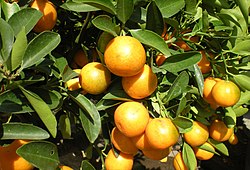Kumquat
The kumquats or cumquats in Australian are a group of small fruit-bearing trees. The edible fruit (which is also called "kumquat") is similar to other Citrus but is smaller.[1]
| Kumquat | |
|---|---|

| |
| Malayan Kumquat foliage and fruit | |
| Scientific classification | |
| Kingdom: | |
| Division: | |
| Class: | |
| Order: | |
| Family: | |
| Genus: | |
| Subgenus: | Fortunella (Swingle) Burkill
|
| Species | |
|
See text | |
Kumquats are slow-growing, evergreen shrubs or small trees, from 2.5 to 4.5 m tall, with dense branches. Sometimes they have small thorns. The leaves are dark glossy green, and the flowers pure white, similar to citrus flowers.[2]
Kumquats came from China (they are known in literature of the 12th century), and have long been cultivated there and in Japan. They were introduced to Europe in 1846 by Robert Fortune, who was collector for the London Horticultural Society, and a short time later into North America.[3]
They are much hardier than citrus plants as oranges. The 'Nagami' kumquat needs a hot summer, ranging from 25 °C(77°F) to 38 °C(100.4 °F), but can withstand frost down to about -10 °C(14 °F). It grows in the tea regions of China where the climate is too cold for other citrus fruits, even the Mikan (also known as the Satsuma) orange.
Etymology
The English name "kumquat" derives from the Cantonese pronunciation gam1 gwat1 (given in Jyutping romanization). The alternate name 柑橘, also pronounced gam gwat in Cantonese (gān jú in Mandarin, literally "large tangerine orange") is now more commonly written by Cantonese speakers.
Names in other Asian languages include:
- Japanese: kinkan (金柑)
- Korean: geumgyul (금귤)
- Mandarin: jīnjú (金橘)
- Thai: somchíd (ส้มจี๊ด)
- Vietnamese: cam quất (from the Cantonese) or, less commonly, (quả) kim quất (if transliterated from the characters 金橘 into Sino-Vietnamese; "quả" (果) is the Sino-Vietnamese prefix for "fruit")
Kumquat Media
Notes
References and other websites
- Fruits of warm climates
- Burkill, I. H. (1931). An enumeration of the species of Paramignya, Atalantia and Citrus, found in Malaya. Gard. Bull. Straits Settlem. 5: 212–220.
- Mabberley, D. J. (1998). Australian Citreae with notes on other Aurantioideae (Rutaceae). Telopea 7 (4): 333-344. Available online Archived 2008-07-30 at the Wayback Machine (pdf).









